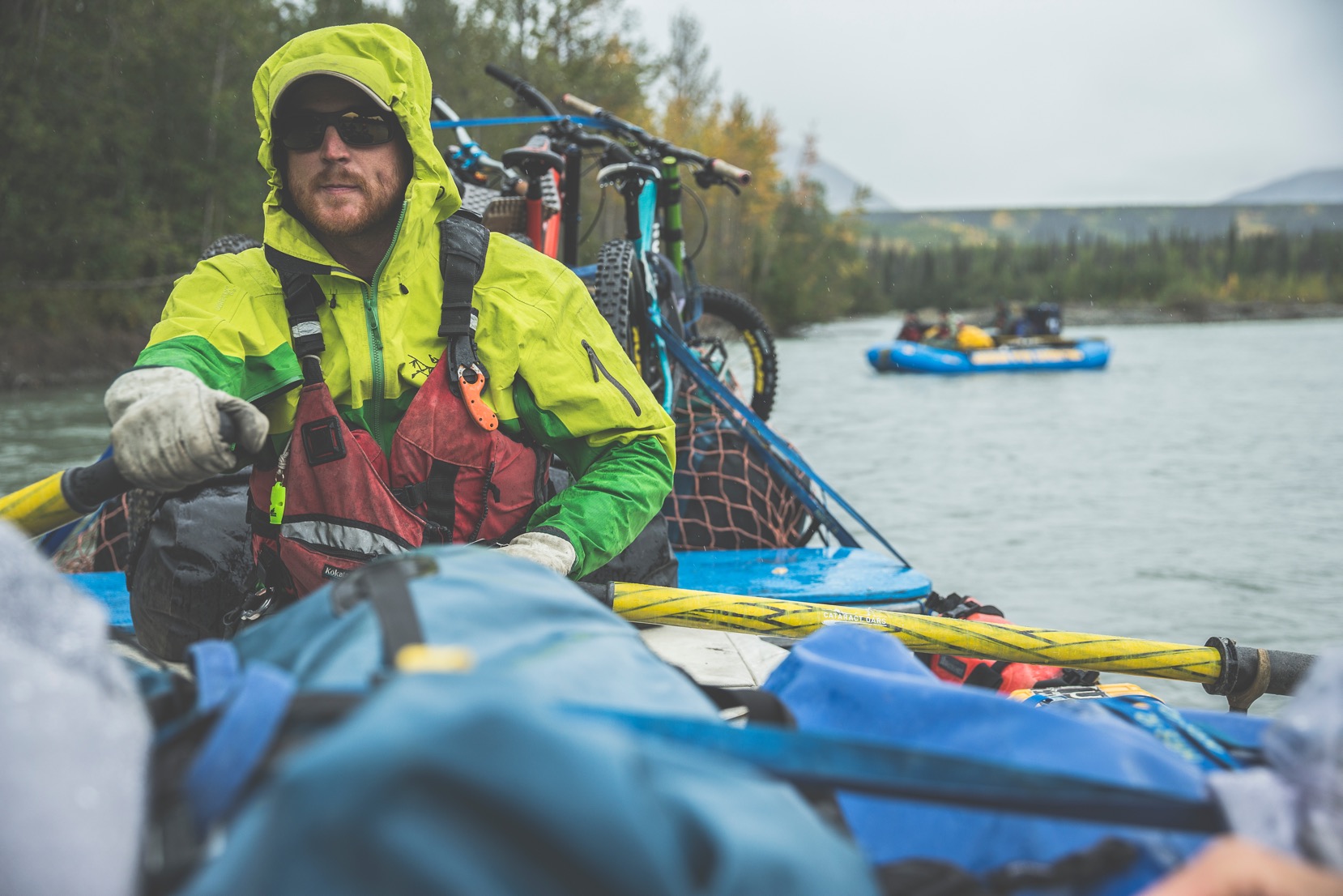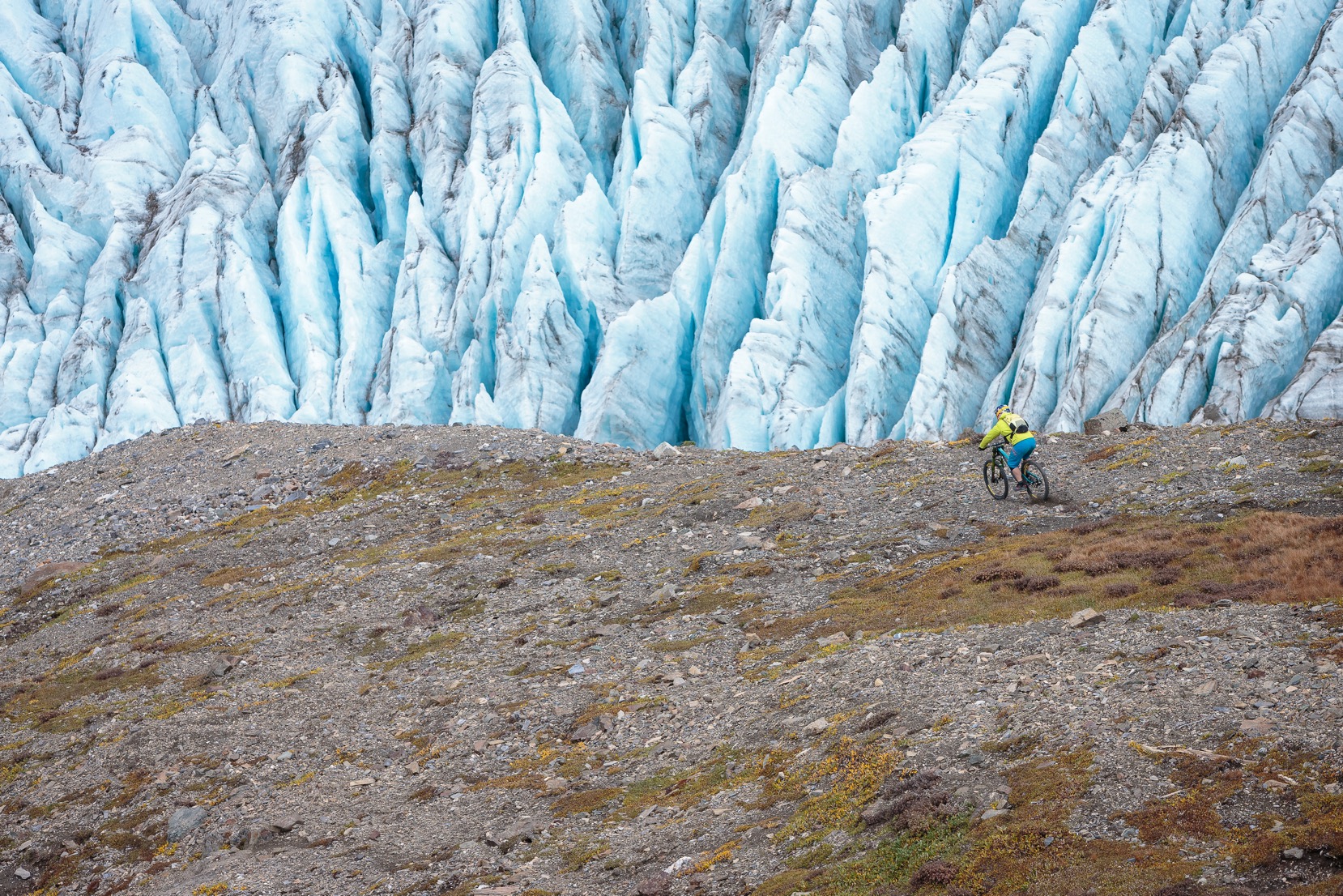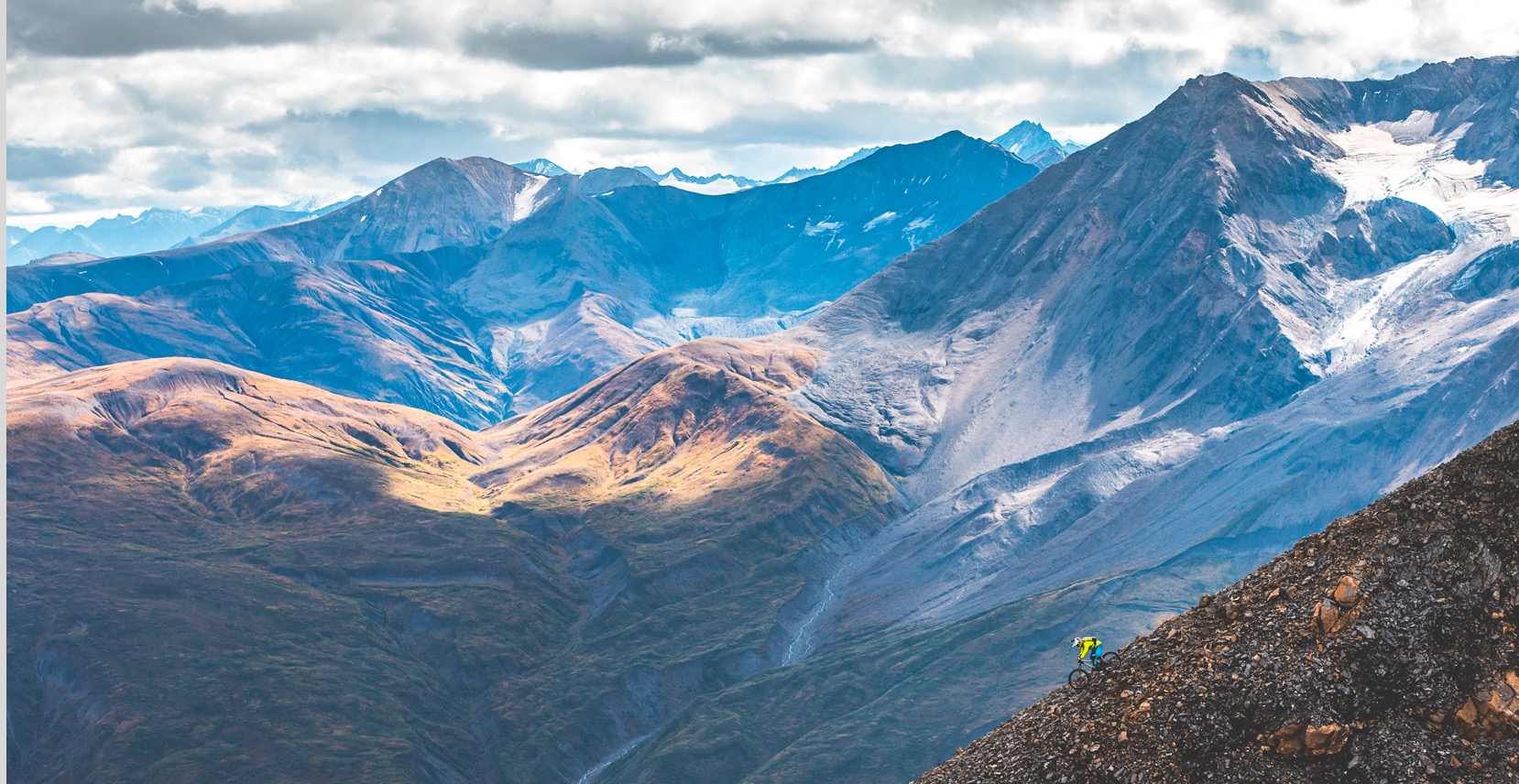Following Four of the World’s Top Mountain Bikers to The Edge of North America
Before the helicopter dipped, mountain biker Carson Storch pointed to a line in the dirt below. “I want to go down that,” he told fellow biker Tyler McCaul. They were high in the B.C. mountains, in the first leg of a two-week trip down the Tatshenshini River. “Do you want to walk down there and make sure the runout is clear?” McCaul asked him. But Storch was confident and didn’t want to waste the energy on what would be a gruelling hike. McCaul stood at the top of a ridge and watched his friend peel down. “He was just a little ant, but we could tell he was going a lot faster than he wanted to go.”
Storch’s tires hit rock, a sensation not unlike skis hitting black ice, and he tomahawked through a field full of boulders. The terrain looked grim — all brown shale where dirt should have been. It was rockier than it had looked from the air, and Storch was bucked from his bike. He landed hard. “That feeling when you just know you can’t control yourself and you can’t control your speed is pretty horrible,” he said later. From a second peak, rider Darren Berrecloth, the third biker on the expedition, heard over the radio that Storch had crashed. “Out here,” Berrecloth says, “there’s no 911 to call.”
Days earlier, four of the world’s leading mountain bikers boarded rafts to take them 260 kilometres down the Tatshenshini River into mountainous terrain spanning British Columbia, the Yukon, and Alaska. The four bikers, plus guides and a film crew, would haul 10 tonnes of supplies using non-motorized rafts. They’d set up and tear down camp nearly every day. Helicopters would drop them on top of unexplored peaks soaring 6,000 feet — or three-and-a-half CN Towers tall — into the air, only for the men to ride down them again on bikes. If it sounds crazy, that’s because it is.

As more and more terrain on the planet gets discovered, explored, and tracked out, athletes are finding new ways to innovate. Consider Sarah McNair-Landry and Erik Boomer, who circumvented Baffin Island by dogsled, or Rebecca Rusch, who summited Mount Kilimanjaro on a mountain bike. And where extreme athletes go, film crews are never far behind. Over the last decade, companies like Red Bull Media House have started to market gorgeously produced films of athletes performing cinematic feats in a range of sports to ever-growing audiences hungry for arm-chair adventure. Participation in those films is how many extreme athletes make enough money to, in this case, keep riding. For context: six million people watched Red Bull’s first TV series.
Those who partake in mountain biking on the weekend, in places like British Columbia, Oregon, and even Norway, look to riders like the four that were on the Tatshenshini trip to show them how far the bounds of their sport can be pushed. They’re an elite squad: Berrecloth, one of two Canadians in the group, has topped podiums across the world and even has a competition, the Bearclaw Invitational, named after him. He’s been doing tricks since he was 12 years old and went pro at age 20. That was 15 years ago. McCaul made his name in racing down in California before switching to focus on freeriding. Wade Simmons is the godfather of freeriding, a 42-year-old rider who’s still shredding mountains. And Carson Storch is a 24-year-old who’s known more for jumping mountain bikes than he is for riding down actual mountains. All four have travelled the world on bikes, but the Tatshenshini trip was different. For one, the riders were part of a team dragging their own gear up a river, an unusual added challenge to an already physically demanding expedition. Two, they’d be contending with environmental factors — grizzly bears, Alaskan storms, days of rain — that would add pressure. Three, the mountains they’d be riding down are incredibly tall. And four, though they’d scouted the terrain, the lines they’d be riding off these peaks were largely unknown, making it a greater adventure — and a riskier undertaking.
Often, real adventure-seeking means devoting one’s life to loving a pursuit that doesn’t always love you back. For McCaul, that has meant breaking his leg in the middle of his 2014 competition season, and suffering from a concussion and bleeding lungs the following year. Berrecloth has broken nearly every bone in his body, including his back three times. In 2014, he had to relearn how to walk, then relearn how to bike. Five months later, he was pulling tricks on his bikes again.
But research from the Queensland University of Technology in Brisbane, Australia, shows that extreme athletes aren’t thrill seekers. Instead, what they’re after is the Zen-like state offered by careful planning and pushing past their fears. When I ask Berrecloth to explain why he does what he does, he pauses. “To stand on top of a mountain peak that no one’s ever stood on before,” he says, “you have to understand that for yourself.”
Like its terrain, the inception of freeriding as a sport was anything but smooth. After a few riders spent years going off trail in their kneepads, jumping off cliffs and sending tapes of their antics to bike companies, hoping to land sponsorship deals, Rocky Mountain, a Vancouver bicycle manufacturer, sponsored the first team in 1997. The first freeride film, Pulp Traction, was sponsored by biking megagiant Specialized but was pulled from shelves after the International Mountain Biking Association and a slew of riders expressed concern about the safety risks. “Back then, these guys were just riding off cliffs and praying for the best. Nobody really knew what you could do on a bike,” McCaul says.
As pioneers continued to ride through the mountains, the sport caught on, and competitions are now held annually around the world by companies such as Red Bull.
Today, riding big-mountain lines means a helicopter drop-in with bikes in tow, into terrain riders have only ever seen from high in the sky. “Every little rock we saw from above was actually a massive rock on the ground,” McCaul says. “You’re trying to use your memory to remember where the no-go zones are, where the cliffs are.” It can be treacherous work.

These four are as professional as they come in the freeride world, but nature can be unforgiving. Storch’s crash, on day three, shook up the rest of the team, which realized they were in tougher terrain than they were used to and would have to work harder to control their speeds. There were frustrating eight-hour days doing nothing but floating on a raft in the rain. There was the trio of grizzlies who saw humans for possibly the first time as the four waited in chilled, falling darkness on a mountain peak for a helicopter to pick them up. There was the day they spent camping on Alaska’s wall of death near Alsek Lake, in winds upwards of 100 kilometres an hour, caught in a storm that blew their base camp away. “We could hear the icebergs calving. We knew that those make tsunamis sometimes. When a big gust of wind would come, it was like a wall had hit our tents,” he says. “You’re just sitting there wondering if it’s wind or water.”
And yet, somehow, it’s the added grind that bolsters the reward, increasing the satisfaction that comes from working for your adrenaline rush on and off the trail. “At the bike parks, you don’t have to do the work, rough it in the mountains and camp,” McCaul says. “But there’s no such thing as a freeride big-mountain bike park. You have to work for it — and it’s never easy.”
A trip like the Tatshenshini doesn’t have any obvious scientific or even exploratory value, though a documentary like the one Freeride Entertainment is producing will take its viewers to a part of the world they may never touch with their own feet. To those outside the world of extreme sports, it can look like nothing more than four men careening down mountains, one loose piece of rock away from a mangled jaw.
Still, for as long as we have walked the earth, there have been humans hardwired to push their limits and, by extension, the bounds of what is possible. The best, and simplest, justification for this comes from famous British mountaineer George Mallory: “There is no scientific end to be served; simply the gratification of the impulse of achievement, the indomitable desire to see what lies beyond the heart of man,” he wrote in Climbing Everest. “What we get from this adventure is just sheer joy.”
Halfway through the trip, confidence was mounting and faces that had initially looked too challenging started calling to Berrecloth. After their morning drop, he’d noticed a long chute line snaking down a mountain face. “It would be amazing if I could ride something like that,” he said to himself. As the hours passed, that turned into “I think I want to try it,” which turned into “I’m sitting at the top of the line and the cameras are on and I’m ready to go.” He grasped the handlebars of his green Canyon Sender and, as they say, sent it.
As he leaned into the line, helmet rattling around his head and rock, shale, and dirt spewing in his wake, he felt time slow down. “I thought I was going to be able to slow down in one area and regain my composure on a shoulder of the chute,” he says. “I ended up coming in so hot that I couldn’t. You get into fight-or-flight mode and fall back on your instincts. It’s the only option you’ve got.”
At the bottom, he tore off his goggles and whooped, mind racing and the question of worthwhile pursuits so far behind him in the rear-view that he couldn’t even see it anymore. “What’s so amazing about big-mountain lines is that no one’s done them before,” he says. “You have to think on the fly and use your reactions. That, to me, is the ultimate lure.”










